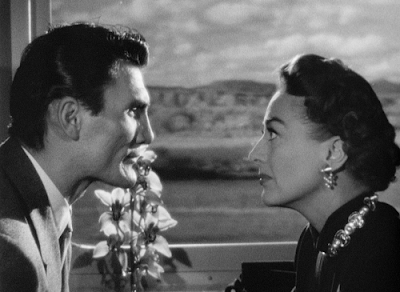Women
are in charge in David Miller’s Sudden Fear,
an unusual postwar crime drama which sets up as a vehicle for Joan Crawford but
dénoues in a wild night chase in San Francisco.
Crawford
plays Myra Hudson, a San Francisco heiress who has become a successful Broadway
playwright. Myra, like Crawford, is an active professional in charge of her
world. Her manner leaves little doubt that she has been
in charge all her life. She sits in on a rehearsal of her latest play with the
producer and director as they watch their rangy male lead Lester Blaine (Jack
Palance) tread heavily on the boards. She tells her producer and director that
Blaine is all wrong as a romantic lead and asks that they replace him. This
narrative trope reliably brings Myra and Blaine together. Ultimately they
marry.
So,
a rich, powerful, driven woman finds a tall, dark, handsome—and
younger—stranger, a struggling actor (this film was Palance’s break-out role);
she makes this rough diamond her husband and softens ecstatically into the
fairytale glow. But this is a crime drama. It is no plot spoiler to say that
Irene Neves (Gloria Grahame), an attractive New Yorker who suddenly turns up in
San Francisco, has an unsavory history with Blaine. The two have trouble
keeping their hands off each other; they are the keener yet to get them on
Myra’s fortune.
Introducing her home life to the dutifully attentive Blaine, Myra
says that she “writes” with a voice-activated Dictaphone which records her
thoughts as she speaks them pacing her study. She demonstrates how it works.
This makes for another reliable narrative trope: Blaine and Irene plot Myra’s
demise in whispers her study, unaware that the machine is on. Myra, rosy with
connubial contentment, is stricken when she discovers the recording. Her
fairytale romance becomes a paranoid nightmare.
But
here the crime drama kicks into motion with superb acting and some of film
noir’s most memorable shots. Where a well-connected person like Myra might
simply have passed on the inadvertent recording to a law enforcement official,
Myra first recoils in paranoia; then she goes gothic; and then she coolly
counterplots against her would-be killers. Her transformation takes place
through a camera that loves Crawford’s unique face. Incidental objects such as
a pendulum desk clock and a mechanical dog take on surreal properties. Elmer
Bernstein’s musical score helps itself to Igor Stravinsky’s “Rite of Spring”.
Like
many organized people, Myra begins with a list. She visualizes each step.
Blaine and Irene are common grifters clearly out of their depth here. Myra
mentally debates like Hamlet: Will her love for Lester save him? And then she
screws her courage to the sticking place. She pulls on a scarf and coat and
dashes to the dénouement from her home in Pacific Heights to Russian Hill.
 |
A
reliable narrative trope brings Myra (Joan Crawford) and
Lester (Jack Palance)
together in Sudden Fear (1952).
|
Three’s a crowd: Gloria Grahame, Jack Palance and
Joan Crawford in Sudden
Fear (1952).
|
 |
Shadows and whispers: Myra’s (Joan Crawford) fairytale
becomes a paranoid nightmare in Sudden Fear (1952).
|
Incidental
objects take on surreal properties
in
David Miller’s Sudden Fear (1952).
|
 |
Joan
Crawford’s Myra Hudson dashes from her home in Pacific Heights
to Russian Hill to outmaneuver would-be killers in Sudden Fear (1952). |
This
film enchanted the young François Truffaut. His review Les extrêmes me touchent (Number 21, March 1953) was his first for Cahiers de cinema.
As executive director, Crawford exercised influence in selecting the material, hiring a writer, picking the crew, and casting the roles. The film was made in the twilight of the studio system after she was released from a long-term contract with Warner Brothers. It was a financial success and earned Academy Award nominations for Crawford, Palance, cinematographer Charles Lang, and costumer designer Sheila O’Brien.
As executive director, Crawford exercised influence in selecting the material, hiring a writer, picking the crew, and casting the roles. The film was made in the twilight of the studio system after she was released from a long-term contract with Warner Brothers. It was a financial success and earned Academy Award nominations for Crawford, Palance, cinematographer Charles Lang, and costumer designer Sheila O’Brien.
Hollywood
legend Charles Lang’s camera loves Joan
Crawford’s unique face in Sudden Fear (1952). |
Sudden Fear (1952) US (112 minutes) RKO Radio Pictures. directed by David Miller; screenplay by Lenore Coffee and Robert Smith, based on the novel by Edna Sherry, with Joan Crawford as an uncredited collaborating writer; cinematography by Charles Lang; editing by Leon Barsha; music director Elmer Bernstein; produced by Joe Kaufman and Joan Crawford.
